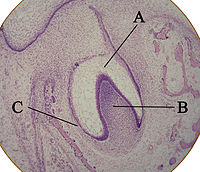
Photo from wikipedia
How does the sex chromosome complement affect the transcriptome and development of oocytes during follicular growth in the mouse ovary? Highly expressed X-linked genes adjust their transcript levels according to… Click to show full abstract
How does the sex chromosome complement affect the transcriptome and development of oocytes during follicular growth in the mouse ovary? Highly expressed X-linked genes adjust their transcript levels according to the X dosage. Y-linked genes affect the transcript levels of some X-linked and autosomal genes. Female mice carrying XO and XY chromosomes on the C57BL/6J (B6) genetic background are healthy but encounter subfertility and infertility, respectively. Our previous results have shown that the XY oocyte is defective in its cytoplasm; its replacement with that of an XX oocyte at the GV stage allows for production of healthy offspring after fertilization. Since transcription is shut down in the oocyte by the end of growth phase, the mRNAs and proteins necessary for meiotic progression and early embryonic development are accumulated during follicular growth. 30 oocytes of 50–59 μm diameter were pooled for each genotype in biological triplicate and subjected to RNA-Sequencing. Total RNA extracted from 10–30 pooled oocytes of each size range and genotype in biological triplicate were subjected to qRT-PCR. All experiments were performed between 2019–2021. XY and XO females were generated by cross between B6 females with B6.YTIR and B6.XPafY males, respectively. Oocytes in the growth phase were collected at 8–18 days postpartum (dpp), whereas fully-grown oocytes were collected at 27–29 dpp after injection with equine chorionic gonadotropin. Oocytes of 50–59 μm diameter were subjected to RNA-Sequencing using a version of SmartSeq2, followed by DEG analyses. Transcript levels in the oocytes of various diameters were determined by qRT-PCR. Chromatin configuration, mitochondrial distribution, and de novo transcription were largely comparable among the XX, XO, and XY oocytes smaller than 60 µm. Three way comparisons of RNA-Seq data in the oocytes of 50–59 μm revealed; (1) 13.8% of X-linked DEGs showed the transcript levels in correspond to the X chromosome dosage; (2) 9 genes on the Y short arm and 2 genes near the distal end of the Y long arm were highly expressed in XY oocytes; (3) transcript levels of X- or autosomal homologs were affected by the XY complement compared to XX and XO oocytes; and (4) 54 and 39 X-linked and autosomal genes show higher and lower transcript levels, respectively, in XY oocytes compared to XX and XO oocytes. The results of qRT-PCR of selected genes revealed distinct dynamic changes in transcript levels in the oocyte during follicular growth. Data of RNA-Seq were statistically analyzed using R Bioconductor limma package for differentially expressed genes having Benjamini-Hochberg adjusted P values lower than 0.01 and log2 fold change higher than 1. All data of qRT-PCR were statistically analyzed by one-way ANOVA followed by Tukey’s honestly significant difference (HSD) test. In humans, most XO females die in utero and those who reach the term suffer from congenital abnormalities and infertility (Turner’s syndrome). However, the severer phenotype can be attributed to somatic cells with a greater number of genes that escape from X chromosome inactivation in humans than mice. Wider implications of the findings: XO and XY mice provide animal models for investigating the consequence of X haplodeficiency in the female germline, independent of somatic defects. Furthermore, XY female mice provide a unique opportunity for examining whether and how Y-linked genes are transcribed outside the male germline. Not applicable
Journal Title: Human Reproduction
Year Published: 2021
Link to full text (if available)
Share on Social Media: Sign Up to like & get
recommendations!